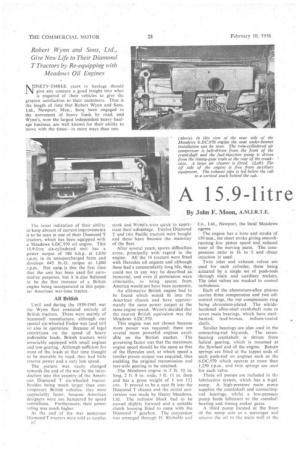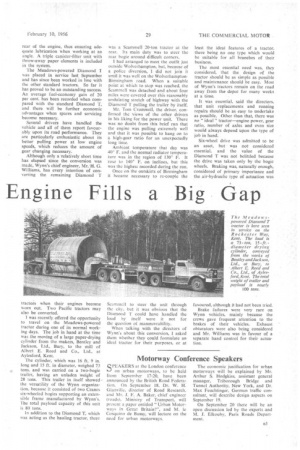A 15.9-litre Engine Fills a Big Gap
Page 20

Page 21

If you've noticed an error in this article please click here to report it so we can fix it.
Robert ,Wynn and Sons, Ltd., Give New Life to Their Diamond T Tractors by Re-equipping with Meadows Oil Engines
By John F. Moon, A.M.I.R.T.E. NTINETY-THREE years in haulage should N give any concern a good insight into what is required of their vehicles to give the greatest satisfaction to their customers: That is the length of time that Robert Wynn and Sons, Ltd., Newport, . Mon., have been engaged in the movement of heavy loads by road, and Wynn's, now the largest independent heavy haulage business, are well known for their ability to move with the times—in more ways than one.
The latest indication of their ability to keep abreast of current irriprovernents is to be seen in one of their Diamond T tractors, which has been equipped with a Meadows 6.DC.970 oil engine. This15.9-litre • six-cylindcred unit has a power output of 180 b.h.n, at 1,650 r.p.rn, in its unsupercharged form and develops 645 lb.-ft, torque at 14100 r.p.m. Not only. is this the first time that the unit has been used for automotive purposes, but it is also believed to be the first instance of a British engine being incorporated in this popular American war-time tractor.
All British
Until and during the 1939-1945 war the Wynn fleet consisted entirely of British tractors. These were mainly of Scammell manufacture, although one special six-wheeled Foden was (and still is) also in operation. Because of legal restrictions on the speed of heavy indivisible loads, British tractors were invariably equipped with small engines and low gearing. Although sufficient for most of the loads at that time thought to be movable by road, they had little reserve power and a very low speed.
The picture was vastly changed towards the end of the war by the introduction into this country of the American Diamond T six-wheeled tractor. Besides being much larger than contemporary. British vehicles, they were appreciably faster, because American designers were not hampered by speed restrictions. Furthermore, their power rating was much higher.
At the end of the war numerous Diamond T tractors were sold as surplus n2 stock and Wynn's were quick" to appreciate their advantage... Twelve. Diamond T and two Pacific -tractors were bought and these have become the mainstay Of the fleet. .
After several years, spares difficulties arose, principally with regard to the engine. All the 14 tractorswere fitted with Hercules oil engines arid although these had a commendably long life, they could not in any way be described as immortal, and even if, permission were obtainable, to bring spares from America would not have been economic.
An alternative British engine had to be found which would fit into the American chassis and have approximately the same power output at the same engine speed. Wynn's decided that the nearest British equivalent was the Meadows 6.DC.970.
This engine was not chosen because more power was required; there arc several more powerful engines available on the British market. The governing factor was that the maximum engine speed should be the same as that of the Hercules unit, at which speed a similar power output was required, thus enabling the original transmission and rear-axle gearing to be retained.
The Meadows engine is 5 ft. 31 in. long, 2 ft. 8 in wide, 3 ft. 11 in. deep and has a gross weight of 1 ton 111 cwt. It proved to be a neat fit into the Diamond T chassis and the initial conversion was made by Henry Meadows, Ltd. The radiator block had to be moved slightly forward and a suitable clutch housing fitted to mate with the Diamond T gearbox. The conversion was arranged through H. Richahls and
co., Ltd., Newport, the localMeadows
agents.
The engine has a bore and Stroke of 150 mm., the short stroke giving smoothrunning low piston speed and reduced wear of the moving parts. The compression ratio is 16 to 1 and • direct injection is-used.
Twin inlet and exhaust valves are used for each cylinder, these being actuated by a single set of push-rods through main and .auxiliary rockers. The inlet valves 'are masked to control turbulence.• Each of the aluminium-alloy pistons carries three compression and two oilcontrol rings, the top compression ring being chromium-plated. The nitridehardened alloy-steel crankshaft runs in seven main bearings, which have steelbacked, lead-bronze, indium-coated shells.
Similar bearings are also used in the connecting-rod big-ends. The sevenbearing crankshaft is driven from helical gearing, which is mounted at the flywheel end of the engine. Return springs arc fitted at the tappet ends of each push-rod on engines such as the 6,DC.970 which operate at more than 1,250 r.p.m., and twin springs are used for each valve.
Three oil pumps are included in the lubrication system, which has a 6-gal. sump. A high-pressure main pump supplies the crankshaft and connectingrod bearings, whilst a • low-pressure pump feeds lubricant to the camshaft bearing and timing rocker gears.
A third pump located at the front of the sump acts as a scavenger and returns the oil to the main well at the rear of the engine, thus ensuring adequate lubrication when working at an angle. A triple canister-filter unit with throw-away paper elements is included in the system.
The Meadows-powered Diamond I was placed in service last. September and has since been worked in line with the other standard tractors. So far it has proved to be an outstanding success. An average fuel-economy gain of 20 per cent, has been recorded when compared with the standard Diamond 1', and there will be further economic advantages when spares and servicing become necessary.
Several drivers have handled the vehicle and all of them report favourably upon its road performance. They arc particularly enthusiastic about its better pulling power at low engine speeds, which reduces the amount of gear changing necessary.
Although only a 'relatively short time has elapsed since the conversion was made, Wynn's chief engineer, Mr. 'H. G. Williams, has every intention of converting the remaining Diamond T tractors when their engines become worn out. Two Pacific tractors may also be converted.
I was recently offered the opportunity to travel on the Meadows-powered tractor during one of its normal working days. The job in hand at the time was the moving of a large paper-drying cylinder from the makers, Bentley and Jackson, Ltd., Bury, to the mill of Albert E. Reed and Co., Ltd., at Aylesford, Kent.
The cylinder, which was 16 ft. 9 in. long and 15 ft. in diameter, weighed 73 tons, and was carried on a two-bogie trailer, having an unladen weight of 28 tons. This trailer in itself showed the versatility of the Wynn organization, because it consisted of two Cranes six-wheeled bogies supporting an extensible frame manufactured by Wynn's. The total payload capacity of this unit is 80 tons.
In addition to the Diamond T, which was acting as the hauling tractor, there was a Scammell 20-ton tractor at the rear. Its main duty was to steer the rear bogie around difficult corners.
I had arranged to meet the outfit just outside Wolverhampton, but, because of a police diversion, I did not join it until it was well on the WolverhamptonBirmingham road. When a suitable point at which to stop was reached, the Scammelt was detached and about four miles were covered over this reasonably undulating stretch of highway with the Diamond T pulling the trailer by itself.
Mr. Tom Cromwell, the driver, confirmed the views of the other drivers in his liking for the power unit. There was no doubt from this brief run that the engine was pulling extremely well and that it was possible to hang on to a high-gear ratio for an unexpectedly long time.
Ambient temperature that day was 40° F. and the normal radiator temperature was in the region of 130° F. It rose to 140° F. on inclines, but this was the highest recorded during the run.
Once on the outskirts of Birmingham it became necessary to re-couple the Scammell to steer the unit through the city, but it was obvious that the Diamond T could have handled the load by itself were it not for the question of maneeuvrability.
When talking with the directors of Wynn's about this conversion, I asked them whether they could formulate an ideal tractor for their purposes, or at least the ideal features of a tractor, there being no one type which would be suitable for all branches of their business.
The most essential need was, they considered, that the design of the tractor should be as simple as possible and maintenance should be easy. Most of Wynn's tractors remain on the road away from tha depot for many weeks at a time.
It was essential, said the directors, that unit replacements and running repairs should be as easy to undertake as possible. Other than that, there was no " ideal " tractor—engine power, gear ratio, number of axles and even size would always depend upon the type of job in hand.
Six-wheel drive was admitted to be an asset, but was not considered essential, and the value of the Diamond T was not belittled because the drive was taken only by the bogie wheels. Braking was, naturally enough, considered of primary importance and the air-hydraulic type of actuation was favoured, although it had not been tried.
Brake failures were very rare on Wynn vehicles, mainly because the crews gave frequent attention to the brakes of their vehicles. Exhaust obturators were also being considered and Mr. Williams was in favour of a separate hand control for their actuation.












































